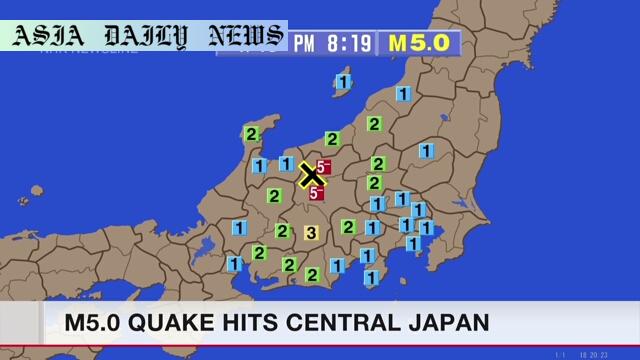Earthquake: A magnitude 5.1 earthquake struck central Japan at 8:19 p.m., with its epicenter in Nagano Prefecture, at a depth of 13 km.
An M5.1 earthquake struck Nagano Prefecture, Japan, on Friday at 8:19 PM local time.
The earthquake’s epicenter was in northern Nagano, with a depth of 13 kilometers.
It measured a lower 5 on Japan’s intensity scale, but no tsunami threat has been reported.

Magnitude 5.1 Earthquake Hits Central Japan
On Friday, central Japan experienced a magnitude 5.1 earthquake at approximately 8:19 PM local time. The Japan Meteorological Agency (JMA) has confirmed that the earthquake’s epicenter was located in Nagano Prefecture, specifically in its northern part, at a depth of 13 kilometers. This significant seismic event measured an intensity of lower 5 on Japan’s shindo scale, which ranges from 0 to 7 and assesses the intensity of shaking.
Despite its impact, the JMA has assured the public that there is no immediate threat of a tsunami. While this offers some relief, the residents of Nagano Prefecture and surrounding areas are undoubtedly on edge as they assess structural damage and the safety of their environment. Earthquakes of this scale often serve as a stark reminder of Japan’s susceptibility to seismic activity, given its location along the Pacific Ring of Fire.
How Earthquakes Affect Local Communities
The shaking in Nagano Prefecture may have disrupted local daily life, affecting transport systems, business operations, and public services. Residents were likely alerted through Japan’s advanced earthquake early warning systems, which played a key role in saving lives and preventing large-scale panics. Citizens usually rely on government-issued guidelines, including seeking shelter under sturdy furniture and ensuring safety before venturing outside.
Japan’s stringent building codes are designed to withstand such earthquakes, which could have mitigated the level of structural damage. Public structures like schools, hospitals, and government offices are built to endure significant seismic activity, ensuring the safety of their occupants during emergencies. However, localized damage and anxiety among the population are inevitable consequences of earthquakes, affecting both physical and mental well-being.
Japan’s Relationship with Seismic Activity
Japan sits at the convergence of four tectonic plates: the Pacific, Philippine, Eurasian, and North American Plates. Because of its geographical positioning, the country experiences frequent seismic and volcanic activity. Over the years, Japan has adopted cutting-edge technology and systems to monitor and mitigate the impacts of earthquakes. Both the resiliency of infrastructure and response readiness have helped Japan navigate these challenges more effectively than most countries.
Despite these advancements, the psychological toll on citizens living in earthquake-prone regions cannot be understated. Families often participate in disaster preparation drills, ensuring they have access to emergency kits, water supplies, and evacuation plans. This forward-thinking culture has undoubtedly saved countless lives but also underscores the constant vigilance required of those residing in tectonically active zones.
Looking Ahead
The recent earthquake serves as an important reminder for Japan to continually update its earthquake preparedness measures and inform its citizens about ongoing safety protocols. Advances in early detection systems and infrastructure must remain a national priority to reduce risks. In tandem, counseling programs and mental health outreach should support those grappling with fear and anxiety caused by seismic events.
For now, authorities in Nagano Prefecture will likely carry out thorough inspections of local houses, roadways, and critical utilities like water and electricity. Monitoring and updates from the JMA will be crucial in informing communities about aftershocks or additional risks. By maintaining robust systems and fostering community awareness, Japan continues to provide a model for earthquake preparedness to nations worldwide.
Commentary
Understanding the Severity of the Nagano Earthquake
The M5.1 earthquake that shook central Japan is yet another reminder of the country’s persistent struggle with nature’s force. Japan’s geographic position, while stunningly beautiful, places it in the precarious context of frequent seismic activity. The magnitude and depth of the recent quake—while moderate—illustrate the power and unpredictability of these natural occurrences. For those of us living far from such seismic zones, it is hard to imagine the constant tension that Japanese residents must endure.
Preparedness Versus Panic
One of the most remarkable aspects of Japan’s response to such natural calamities is its level-headedness and preparedness. Reflecting on the quake, it’s awe-inspiring how effectively Japan has turned technology into a lifeline for its citizens. Be it earthquake warning systems, reinforced buildings, or community preparedness drills—the country’s foresight in living harmoniously with natural disasters sets a global standard. However, technology and preparedness can only mask but not entirely eliminate the human cost of these events.
A Lesson for the World
The Nagano earthquake highlights lessons not just for Japan but for the global community. Earthquakes of similar magnitudes have caused devastation elsewhere, often due to lack of preparedness, inadequate infrastructure, or insufficient community education. Japan’s proactive measures should serve as an inspiration for other parts of the world, particularly areas along tectonic fault zones. The importance of building earthquake-resilient structures and educating communities about disaster response needs to be emphasized globally.
Concluding Thoughts
Ultimately, the earthquake that struck Nagano reminds us of nature’s unyielding might and the resilience required to confront it. For Japan, it’s a continuation of their story as a nation that adapts and innovates in response to adversity. Let us take a moment of solidarity to reflect on the resilience of the affected communities, and perhaps, draw inspiration from their perseverance.


